|
|
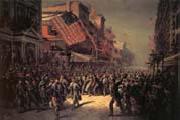 |
Thomas Nast
|
|
September 27, 1840 ?C December 7, 1902,Illustrator Thomas Nast was the first American celebrity cartoonist, famous for helping to turn out New York corrupt politicians and for creating peristent iconographic images of Santa Claus. Nast, from a family of German immigrants, began working in New York City as a cartoonist at the age of 15. He had a long association with Harper Weekly (1861-86), during which his battlefield illustrations and skilled caricatures made him famous in the U.S. and abroad (Van Gogh was a collector). Nast was an opinionated, progressive Republican, and his illustrated attacks on the leader of New York Democrats, William Boss Tweed, are said to have helped bring down an era of government corruption. One of the most influential caricaturists of his time, he is credited with creating the image of Santa as a chubby fellow in a red suit. Nast also came up with the image of an ass to represent Democrats (around 1870) and an elephant to represent Republicans (1874). His popularity waned in the 1880s, and he parted ways with Harper Weekly over political and artistic differences. Failing to succeed with his own publication or as a painter, he managed to be appointed by President Teddy Roosevelt in 1902 to a diplomatic position in Ecuador, where he contracted yellow fever and died. Now officially embraced icons, the animal symbols of the two political parties were meant by Nast to be unflattering. |
|
|
|
 |
Thomas Patch
|
|
1725 - 1782
was an English painter, engraver and caricaturist. He made a living by basing himself in Italy and undertaking commissions from rich young British men on Grand tours.His paintings today are in the Royal Collection and various museums. Patch was thrown out of Rome for a homosexual act. Patch was born in Exeter in 1725, the son of a doctor. He had not completed his medical studies when he came to Rome in 1747 as a grand tourist and where he met Joshua Reynolds. Initially he worked for Joseph Vernet, creating landscapes of Tivoli and pastiches of Vernet's work. He was forced to leave Rome after some homosexual He was in Florence in 1755, where he was commissioned to paint people on their Grand tours. Here he was assisted by his friendship with Sir Horace Mann, who was the British envoy and therefore a point of contact with British tourists arriving in Florence. While there he completed studies of human physiognomy, looking at the expressions and facial types as well as completing portraits of many in the British society in Florence. He also studied the old masters and published studies of them. Towards the end of his life his output of paintings slowed.Patch was also known to be an art dealer. In about 1763, Patch completed three views of Florence that are now part of the Royal Collection. They are thought to have been bought by George III. On October 19, 1767, he was enterprising enough to witness the eruptions of Mount Vesuvius which he painted from both the land and the sea. |
|
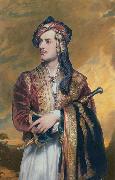 |
Thomas Phillips
|
|
(18 October 1770 - 20 April 1845) was a leading English portrait and subject painter. He painted many of the great men of the day including scientists, artists, writers, poets and explorers.
Phillips was born at Dudley then in Worcestershire. Having acquired the art of glass-painting in Birmingham under Francis Eginton,[1] he visited London in 1790 with an introduction to Benjamin West, who found him employment on the painted-glass windows of St George's Chapel at Windsor. In 1791, he became a student of the Royal Academy, and exhibited there, in 1792, a view of Windsor Castle, followed in the next two years by the "Death of Talbot, Earl of Shrewsbury, at the Battle of Castillon," "Ruth and Naomi," "Elijah restoring the Widow's Son," "Cupid disarmed by Euphrosyne," and other pictures.
After 1796, he mainly confined himself to portrait-painting. However, the field was very crowded with the likes of John Hoppner, William Owen, Thomas Lawrence and Martin Archer Shee competing for business; consequently, from 1796 to 1800, his exhibited works were chiefly portraits of gentlemen and ladies, often nameless in the catalogue and of no great importance historically-speaking.
|
|
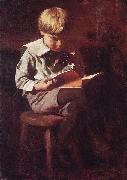 |
Thomas Pollock Anshutz
|
|
(1851-1912) was an American painter and teacher.
He studied art at the National Academy of Design in New York City, and moved to Philadelphia in 1875 to study under Thomas Eakins at the Philadelphia Sketch Club. He entered the Pennsylvania Academy of the Fine Arts in 1876, becoming Eakins's assistant there in 1878, and his successor in 1886. He later studied in Paris at the Academie Julian, 1892-93 |
|
 |
Thomas Robertson
|
|
January 9, 1829 ?C February 3, 1871,English dramatist and actor; brother of Madge Kendal. After spending several years as an actor, he turned to playwriting, initiating the ecup and saucere school of drama, which was characterized by its realism and its contemporary, domestic setting. His first successful play, David Garrick (1864), was followed by Society (1865) and Ours (1866). With Caste (1867) he began a close association with Squire Bancroft and his wife, Marie Wilton Bancroft, the actress, and they produced several of his plays. |
|
|
|
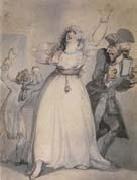 |
Thomas Rowlandson
|
|
English Illustrator, 1756-1827,English caricaturist, watercolourist, draughtsman and engraver. Although he is commonly thought of as a satirist, most of his drawings are gently humorous, and in some cases objective, records of urban and rustic life. With the exception of a small number of topographical drawings, they are characterized by an abundance of picaresque incidents, whether robust or sentimental, and have much in common with the novels of Laurence Sterne and Henry Fielding, which Rowlandson illustrated in 1808 and 1809. |
|
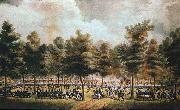 |
Thomas Ruckle
|
|
was a house painter and sign painter in early nineteenth century Baltimore, Maryland, and an amateur painter. He is best known for his paintings The Battle of North Point, and The Defense of Baltimore. Ruckle was a veteran of the War of 1812, in which he had served as a corporal in the 5th Maryland Regiment of the Maryland Militia.
Ruckle was born in Ireland and, having moved to Baltimore, Maryland, he became a sign painter and house painter. It is likely that he had very little, if any, formal training as an artist. |
|
|
|
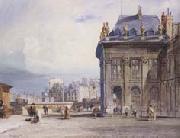 |
Thomas Shotter Boys
|
|
English Engraver, 1803-1874
English painter and printmaker. He was apprenticed on 4 February 1817 to George Cooke. His early training in engraving influenced his future career; his ability to draw a fine line, lay aquatint washes and hand-colour prints was an important factor in the creation of his particularly lucid style of watercolour landscapes and townscapes. At this time Cooke was engraving volumes of picturesque views by Turner and James Hakewell (1778-1843) as well as his own view of the Thames (1822); |
|
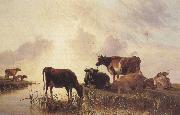 |
Thomas sidney cooper,R.A.
|
|
1803-1902
English painter. He was encouraged in his ambition to become an artist by Sir Thomas Lawrence and the animal painter Abraham Cooper (no relation; 1787-1868). He entered the Royal Academy Schools, London, in 1823. He subsequently taught art in Brussels where he met Eugene Verboeckhoven, whose work had a profound influence on him. Through Verboeckhoven he came to appreciate the work of such 17th-century Dutch painters as Aelbert Cuyp and Paulus Potter. In 1831 he returned to London, exhibiting at the Royal Society of British Artists. He exhibited 48 pictures at the British Institution between 1833 and 1863. The majority of his work was, however, exhibited at the Royal Academy; from 1833 to 1902 he exhibited 266 works there without a break, |
|
|
|
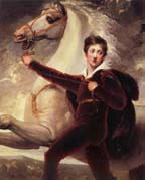 |
Thomas Stothard
|
|
English Neoclassical Painter, 1755-1834,English illustrator, painter and designer. He was one of the most popular, prolific and successful artists of his time and was highly regarded by such contemporaries as Thomas Lawrence and Walter Scott. He was the son of a prosperous publican and completed his apprenticeship as a silk weaver (1770-77), before studying at the Royal Academy, London (1777-c. 1783). From the beginning of his career, book illustration was his main area of activity. His earliest surviving works are in the decorative Rococo mode, but he soon adopted the more idealistic Neo-classicism of John Hamilton Mortimer and James Barry. Together with his friends and near contemporaries, William Blake and John Flaxman, Stothard developed an austere, linear style of draughtsmanship. |
|
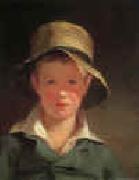 |
Thomas Sully
|
|
1783-1872
Thomas Sully Galleries
Sully became a professional painter at age 18 in 1801. He studied face-painting under Gilbert Stuart in Boston for three weeks. After some time in Virginia with this brother, Sully moved to New York, after which he moved to Philadelphia in 1806, where he resided for the remainder of his life. In 1809 he traveled to London for nine months of study under Benjamin West.
Sully's 1824 portraits of John Quincy Adams, who became President within the year, and then the Marquis de Lafayette appear to have brought him to the forefront of his day. (His Adams portrait may be seen in the National Gallery of Art, Washington.) Many famous Americans of the day had their portraits painted by him. In 1837-1838 he was in London to paint Queen Victoria at the request of Philadelphia's St. George's Society. His daughter Blanche assisted him as the Queen's "stand-in", modeling the Queen's costume when she was not available. One of Sully's portraits of Thomas Jefferson is owned by the Jefferson Literary and Debating Society at the University of Virginia and hangs in that school's Rotunda. Another Jefferson portrait, this one head-to-toe, hangs at West Point, as is his portrait of Alexander Macomb (American general).
Sully's own index indicates that he produced 2631 paintings from 1801, most of which are currently in the United States. His style resembles that of Thomas Lawrence. Though best known as a portrait painter, Sully also made historical pieces and landscapes. An example of the former is the 1819 Passage of the Delaware, now on display at the Museum of Fine Arts, Boston. |
|
|
|
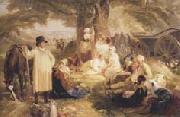 |
Thomas Uwins
|
|
English Painter, 1782-1857
English painter and illustrator. He was apprenticed to the line-engraver Benjamin Smith (d 1833) in 1797, but his greater interest in portrait painting led him to take life classes at the Royal Academy, London; he exhibited portraits there from 1799. Versatile and industrious, he painted miniature likenesses, taught drawing, designed and engraved illustrations for books in French, Portuguese and English, and wrote for and illustrated Rudolph Ackermann's Repository. His half-a-crown watercolours, known as 'pretty faces', were particularly popular, and he found employment as an assiduous copyist. In 1809 he was elected to the Society of Painters in Water-Colours and for the next nine years exhibited careful and colourful images of the countryside that provided views of the year's harvest. In 1817 Uwins travelled to France to record the Burgundian grape harvest, identifying the labour force more obviously as peasants than their English counterparts. In debt, he moved in 1820 to Edinburgh, where he illustrated books by Walter Scott and painted portraits. In 1824, his debt paid, he left for Italy, where he spent seven years; he sent highly valued copies of Italian works back to England (to Thomas Lawrence among others) and made studies of life in and around Rome and Naples, from which his later successes at the Royal Academy derived. An immodest Protestant, Uwins deplored but revelled in the 'polluted streams' of Catholic Italy, and provided London with oils renowned for their clarity and colour. A Neapolitan Saint Manufactory (exh. RA 1832; Leicester, Mus. & A.G.) shows monks haggling, women gazing and children playing amid carved and painted icons. |
|
|
|
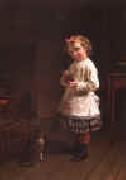 |
Thomas Waterman Wood
|
|
1823-1903
It may be that his reputation as an artist will rest upon his figure pictures, although his very numerous portrait paintings involved much of the effort of his life and are most certainly characterized but simple and strong composition, great technical execution and a masterful use of colors. It may also follow that he will yet achieve his most memorable honors from the interpretations which he has made of great paintings, but from the stand point of those whose minds and hearts are won by considerations of local history the highest interest will be assigned to works in which Wood included characters from his native place. As examples of his work in this direction the following may be mentioned: The Yankee Pedlar had for its model a tin peddler known as "Snapping Tucker", a resident of Calais, Vermont. When this work was sold for a large sum, Tucker promptly claimed his share upon the grounds of his intrinsic worth and natural capacity as a poser. The Village Post Office was taken from the interior of the old Ainsworth store in Williamstown, Vermont, but the figures were mostly taken from Montpelier people. Wood's uncle Zenas was the postmaster and the group around the store, Boyden, Whittier and Bullock, were old-time residents. Their clerk was Horace Scribner, long esteemed as a generous country musician and as the organist of Christ Church. This painting was bought by Mr. Charles Stewart Smith, ex-president of the New York Chamber of Commerce. The scene for the The Quack Doctor was located in front of the old arch which once spanned the head of State Street leading to East State. The old brick building, the home of Montpelier Book Bindery, still stands. This picture was bought by Mr. George I. Seneg for $2,000 and after his death was included in the sale of his entire collection.
Another successful painting was The Country Doctor. The artist found the proper model for this work with the aid of the Secretary of State, Dr. George Nichols, in the person of an actual country doctor, then representing the town of Jamaica in the legislature. This doctor bore upon his face the impress of his beneficent labors for more than 40 years in a back country town. Wood himself told the writer, in speaking of this painting, that many a person had said to him, "That doctor is the exact image of my father, who was also a country doctor." This saying he regarded not so much as proof that he had achieved a concrete likeness but as an evidence of having successfully handed down the particular class idea of the old-fashioned country physician, as truly different in type from the city practitioner as was the country lawyer of former days from his brother in the city.
In 1891, Wood exhibited at the Academy a picture entitled A Cogitation, for which one of his Montpelier friends, Mr. George Ripley, posed. The composition is extremely simple, a farmer in his barn, leaning upon his pitchfork, his countenance thoughtful. This picture was bought by Mr. Harper and published as a full-page engraving in Harper's Weekly during the Greeley campaign over the title "Is Greeley a Fool or a Knave?". The humorous side of this incident consists in the fact that Mr. Ripley was the model was an ardent supporter of Mr. Greeley in that campaign, while the artist himself, so far as we know, never dabbled in politics.
These few examples sufficiently illustrate the influence which the place of his birth had upon Wood. He was not only a Vermonter but a great painter of Vermont ideas, conditions and character. Nor did foreign travel nor city residence nor any influence of professional connections ever tend to diminish the deep and abiding interest in his early home. The subjects of his works, his selection of characters, his yearly pilgrimage to Vermont, all demonstrate his filial loyalty and he gave to this sentiment of his heart its final expression in the establishment, as a gift to Montpelier, of its Gallery of Art. But, apart from this, the homes, offices and institutions of Montpelier and without are filled with the affectionate and great evidences of his work. The Vermont Historical Society possesses several excellent examples of his portraiture, all of great historic value and preserved in the Cedar Creek Reception Room at the Vermont State House: Samuel Prentiss (1881), United States Senator; Mrs. Samuel Prentiss (1895) and Dr. Edward Lamb (1895), gifts to the Society by the family of Mr. Prentiss. In 1896, the Society unveiled a life-size portrait of the distinguished publicist, the Hon. E. P. Walton, the gift of his wife and sister. Wood's personal donations include portraits of the Rev. William A. Lord, D.D. (1874), minister of Bethany Congregational Church of this city, Daniel Pierce Thompson (1880), novelist and author of "The Green Mountain Boys", and Justin S. Morrill, United States Senator, father of tariff legislation, promoter of agricultural colleges and chief up builder of the Library of Congress.
One of the noblest paintings now existing in the state is the artist's beautiful translation of Bartolom?? Esteban Murillo's "La Madonna del Rosario". This work, submitting the original with infinite tenderness and feeling, was painted in 1896 in the Dulwich Gallery and was consecrated by Bishop de Goesbriand for the service of Saint Augustine's Church on July 26, 1897. The essential force of this sacred painting is its actual power to impress the beholder with a profound sense of the sacredness of motherhood and the worth and lasting values of purity and religious faith. In accepting this donation from Wood the Reverend Bishop said: "You have made a great Murillo of the seventeenth century our contemporary," an expression not only true of itself but one which defines the special value of the truly great copies of great paintings. |
|
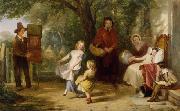 |
Thomas Webster
|
|
(March 10, 1800 - September 23, 1886), was an English genre painter, who lived for many years at the artists' colony in Cranbrook.
Webster was born in Ranelagh Street, Pimlico, London. His father was a member of the household of George III, and the son, having shown an aptitude for music, became a chorister, first at St George's Chapel in Windsor Castle, then the Chapel Royal at St. James's Palace in London. He abandoned music for painting, however, and in 1821 was admitted as a student to the Royal Academy, exhibiting, in 1824, portraits of "Mrs Robinson and Family." In the following year he won first prize in the school of painting.
In Sickness and Health (1843)In 1825, also, Webster exhibited 'Rebels shooting a Prisoner,' at the Suffolk Street Gallery - the first of a series of pictures of schoolboy life for which he subsequently became known - . In 1828 he exhibited 'The gunpowder Plot' at the Royal Academy, and in 1829 'The Prisoner' and 'A Foraging Party aroused' at the British Institution. These were followed by numerous other pictures of school and village life at both galleries. In 1840 Webster was elected an associate of the Royal Academy (ARA), and in 1846 a Royal Academician (RA) academician. He continued to be a frequent exhibitor till 1876, when he retired from the academy. He exhibited his own portrait in 1878, and 'Released from School,' his last picture, in 1879.
In 1856 Webster was photographed at 'The Photographic Institute', London, by Robert Howlett, as part of a series of portraits of 'fine artists'. The picture was among a group exhibited at the Art Treasures Exhibition in Manchester in 1857.
From 1835 to 1856 Webster resided at The Mall, Kensington, but the last thirty years of his life were spent at the artists' colony in Cranbrook, Kent, where he died on 23 Sept. 1886.
|
|
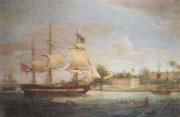 |
Thomas Whitcombe
|
|
British
1760-1824
British 1760-1824 was a British maritime painter Thomas Whitcombe was born in London between 1752 and 19 May 1763, with the latter date frequently cited. Little is known of his background or training, although speculation based on the locations depicted in his paintings may provide some clues. It is known that he was in Bristol in 1787 and later travelled to the South Coast; there are few ports or harbours from this region that do not feature in his work. In 1789 he toured Wales and in 1813 he travelled to Devon, painting scenes around Plymouth harbour. During his career he also painted scenes showing the Cape of Good Hope, Madeira, Cuba and Cape Horn. Between 1783 and 1824 he lived in London. His date of death, like that of his birth is uncertain; it was not before 1824, and possibly as late as 1834. |
|
|
|
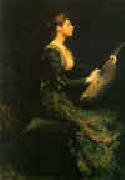 |
Thomas Wilmer Dewing
|
|
1851-1938
Thomas Wilmer Dewing Gallery
was an American painter working at the turn of the 20th century. He was born in Newton Lower Falls, Massachusetts. He studied at the Acad??mie Julian in Paris, and later settled into a studio in New York City. He married Maria Oakey Dewing, an accomplished painter with extensive formal art training and familial links with the art world.
He is best known for his tonalist paintings, a sub-genre of American art that was rooted in English Aestheticism. Dewing's preferred vehicle of artistic expression is the female figure. Often seated playing instruments, writing letters, or engaged in other impassive actions and situated in gauzy, dreamy interiors, the figures remain remote and distant to the viewer. These scenes are infused with a color that pervades the entire picture, setting tone and mood. The ethereal delicacy and subtle color harmonies of Dewing's paintings have not met with universal approval: some feminist critics have lambasted Dewing's work as being misogynistic; he rarely painted anything other than the female figure, vacant of expression, languishing in sumptuous clothing.
Tonalism quickly came to be considered outdated with the advent of modernism and abstraction in art, though Dewing was successful in his own day. His art was considered extremely elegant, and has undergone a subtle revival in the last 10 years or so.
Dewing was a member of the Ten American Painters, a group of American Impressionists who seceded from the Society of American Artists in 1897.
He spent his summers at the art colony in Cornish, New Hampshire. |
|
|
|
|
|
 |
Thornton Oakley
|
|
an illustrator,American , 1881-1953
was an American artist and illustrator. Thornton Oakley was born March 27,1881, in Pittsburgh. He studied at the University of Pennsylvania and received B.S. and M.S. degrees in architecture in 1901 and 1902. He first studied with Howard Pyle in 1902 at Chadds Ford in the mill, and described his first day there in a talk given at the Free Library in Philadelphia in 1951: "There we four - my new cronies - Allen Tupper True, George Harding, Gordon McCouch and I - made our first sketches from a model, and our efforts were frightful to behold! Not one of us had had a palette in our hands ever before: I had not the least idea as to procedure. My attempts were terrifying to behold, and when H.P. came to me to criticize my work he paused for a long, long time before speaking, and I know that he must have been appalled." Oakley studied with Pyle for three years. Oakley became an illustrator and writer for periodicals, including Scribner's, Century, Collier's, and Harper's Monthly. In the years 1914-19 and 1921-36 he was in charge of the Department of Illustration at the Philadelphia Museum School of Industrial Art. In 1914-15 he also taught drawing at the University of Pennsylvania, and gave lectures at the Art Institute of Chicago, the Metropolitan Museum of Art, and the Curtis Institute. He was a member of the jury of selection and advisory committee of the Department of Fine Arts at the Panama-Pacific International Exposition in San Francisco in 1915 and the Philadelphia Sesquicentennial Exposition in 1926. |
|
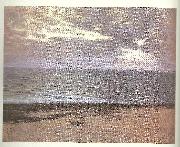 |
thorvald niss
|
|
Født i Assens 07.05.1842, død Frederiksberg 11.05.1905, maler
Det Kgl. Danske Kunstakademi 1861-1869, afbrudt af frivillig deltagelse i krigen 1864.
Otto Baches atelier i 1870'erne |
|
 |
threshing wheat
|
|
early sixteenth century.
paris. muse'e des arts de'coratifs |
|
|
|
|
|
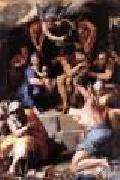 |
TIBALDI, Pellegrino
|
|
Italian Painter, 1527-1596
Painter and architect. Pellegrino Tibaldi's early paintings show the influence of Bagnacavallo and of other Bolognese followers of Raphael, but his actual teacher is unknown. Vasari's claim that his own works in S Michele in Bosco, Bologna, formed Tibaldi's artistic education is hardly borne out by the latter's first efforts. The Mystic Marriage of St Catherine (c. 1545; Bologna, Pin. N.) is, in its classical, hierarchical simplicity, clearly inspired by Raphael's manner as interpreted by his Bolognese imitators; although it also bears delicate marks of Parmigianino's grace, the power of its expressive dignity and the architectural background hint at Tibaldi's future development. Tibaldi's Adoration of the Shepherds |
|
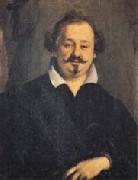 |
Tiberio Tinelli
|
|
Italian Baroque Era Painter, 1586-1638
was an Italian painter of the early-Baroque period, active mainly in his native city of Venice. He trained with Giovanni Contarini, a pupil of the late Titian. Tinelli then either worked under or emulated Leandro Bassano. He was well known for his portraits of aristocracy, merchants, and intellectuals in Venice, whom he often painted in historical dress. His small pictures of historical and mythological subjects were also popular. Some of his pictures found their way into the collection of Louis XIII, king of France, who knighted him with the order of Michael. He moved later in life in Florence. |
|
|
|
 |
tidemand
|
|
Tidemand kom vid 17 års ålder till Köpenhamns konstakademi, studerade där i fem år, tänkte sedan utbilda sig till historiemålare i Munchen, men valde i stället på en kamrats råd Dusseldorf till studieort och reste dit 1837. Han blev elev av Theodor Hildebrandt, men tog tidigare intryck av Carl Friedrich Lessings relativt realistiska historiemåleri. Hans första större målning behandlade ett svenskt ämne, Gustaf Vasa talar till dalkarlarna vid Mora (1841). Målningen inköptes av Rhens och Westfalens konstförening samt förskaffade Tidemand ett resestipendium från Norge och beställning på en altartavla till Vor Freisers kirke i Kristiania.
Han reste sedan till Munchen och Italien, återvände till Norge på ett kort besök sommaren 1842, gjorde en studieresa i fjälltrakterna för att samla material till en påtänkt fosterländsk historiemålning, men kom nu till klarhet över sitt mål. Han ville, som han själv yttrat, skildra detta kraftiga naturfolks karaktär seder och vanor. Hans första tavla i detta syfte var Sagoberätterskan 1844, inköptes av drottning Josefina och förskaffade konstnären medlemskap av svenska konstakademien. Efter nya studieresor i Norge målade han Söndagskväll i Hardanger köptes av Oscar I, på slottet i Kristiania och Gudstjänst i en landskyrka. Han bosatte sig 1845 på allvar i Dusseldorf och vann snart ett namn genom de norska bondelivsbilderna. Samma år målade Tidemand i samarbete med Hans Fredrik Gude den romantiska Brudefärden i Hardanger.
Revolutionsoroligheterna hade vid denna tid drivit de norske konstnärerna hem till Norge, och det såg ut, som skulle konsten nu bli rotfäst i hemlandet. Impulsen till en nationell konst gavs, men då lugn åter inträdde, återvände konstnärerna till utlandet. Under de närmaste åren målade Tidemand för det av Oscar I uppförda lilla lustslottet Oskarshal, som pryddes av uteslutande norska konstverk, serien Norskt bondeliv. Hans sista arbete var förstudier till en aldrig utförd historiemålning, Kristian IV grundlägger Kristiania, beställd av Oscar II. Tidemand skapade även tre altartavlor. I samarbete med Gude målade han Afton på Kröderen (1849), Ljustring (1850), Likfärd på Sognefjorden (1853), Fiskare i fara (1859), med Sophus Jacobsen Lappar på renjakt (1873) och med Morten M??ller Sinclairs landstigning i Romsdalen (1875).
Han blev av sin samtid hyllad som Norges främsta representativa konstnär. Hans betydelse ligger i att han i sin konst gav uttryck åt det nationella uppvaknandet i sitt hemland. På samma gång föreställde han det norska folket för den stora allmänheten i utlandet. I Tyskland betraktades han som en av de främsta representanter i samtidens konst. Han fick många utmärkelser såväl i Tyskland som i Paris och i England, och hans arbeten såldes till höga pris. Sina mest omtyckta målningar upprepade han med tillhjälp av flera medhjälpare gång på gång, några i ända till 12 exemplar. Många av hans arbeten är återgivna i kopparstick och litografi. L. Dietrichson utgav Adolph Tidemand, hans liv og hans værker (2 delar, 1878-79). |
|
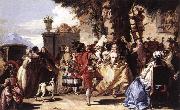 |
TIEPOLO, Giovanni Domenico
|
|
Italian painter, Venetian school (b. 1727, Venezia, d.
1804, Venezia).
Italian painter and printmaker. He was apprenticed to his father, Giovanni Battista Tiepolo, in Venice in the early 1740s and worked with him in Madrid from 1762 until the elder's death in 1770. His most notable early works are the chinoiserie decorations of the Villa Valmarana in Vicenza (1757). Back in Venice, he executed several frescoes and paintings of scenes from the commedia dell'arte. A talented genre painter and caricaturist, he was famous for his many engravings and etchings after his own and his father's designs.
|
|
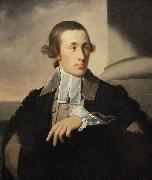 |
Tilly Kettle
|
|
(1735-1786) was a portrait painter and the first English painter to work in India. He was born in London, the son of a coach painter, in a family that had been members of the Brewers' Company of freemen for five generations. He studied drawing with William Shipley in the Strand and first entered professional portraiture in the 1750s.
Kettle's first series of portraits appeared in the 1760s. His first surviving painting is a self-portrait from 1760, with his first exhibit at the Society of Artists in 1761. In 1762, he worked at restoring Robert Streater's ceiling fresco in the Sheldonian Theatre, Oxford, and painted Francis Yarborough, a doctor of Brasenose College, Oxford in 1763. He painted many members of the family of William Legge, 2nd Earl of Dartmouth. In 1764-5, he was active in London and continued exhibiting at the Society of Artists.
In 1768, Kettle sailed to India with the British East India Company, landing at Madras (now Chennai), where he remained for two years. There, he painted Lord Pigot and Muhammad Ali Kahn twice (once alone and once with five of his sons). He also painted non-portraits, including Dancing Girls (Blacks) in 1772 and a suttee scene in 1776 entitled, The ceremony of a gentoo woman taking leave of her relations and distributing her jewels prior to ascending the funeral pyre of her deceased husband. In 1770 Kettle painted a half-length portrait of 'Sir' Levett Hanson, a peripatetic writer on European knighthood and chivalry originally from Yorkshire. (The portrait is now in the collection of the Bury St Edmunds Manor House Museum.)
Kettle moved on to Calcutta (now Kolkata) in 1771 and painted Shuja ud-Daula and Dancing-Girl Holding the Stem of a Hookah. In 1775,he painted George Bogle, Warren Hastings' emissary to Tibet, in Tibetan dress, presenting a ceremonial white scarf to Lobsang Yeshe the 5th Panchen Lama.He also took an Indian mistress and had two daughters by her. |
|
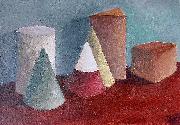 |
Tim Verfaillie
|
|
(Brugge, 14 January 1893 - Rochefort, 1934) was Belgian painter who was one of the smaller figures of Flemish expressionism.
In his younger days he travelled through the Scottish Highlands. The atmosphere he witnessed there would remain an important influence in his work.
|
|
|
|
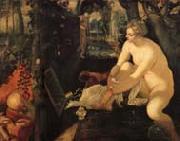 |
Tintoretto
|
|
Italian Mannerist Painter, ca.1518-1594
His father was a silk dyer (tintore); hence the nickname Tintoretto ("Little Dyer"). His early influences include Michelangelo and Titian. In Christ and the Adulteress (c. 1545) figures are set in vast spaces in fanciful perspectives, in distinctly Mannerist style. In 1548 he became the centre of attention of artists and literary men in Venice with his St. Mark Freeing the Slave, so rich in structural elements of post-Michelangelo Roman art that it is surprising to learn that he had never visited Rome. By 1555 he was a famous and sought-after painter, with a style marked by quickness of execution, great vivacity of colour, a predilection for variegated perspective, and a dynamic conception of space. In his most important undertaking, the decoration of Venice's Scuola Grande di San Rocco (1564 C 88), he exhibited his passionate style and profound religious faith. His technique and vision were wholly personal and constantly evolving. |
|
|
|
|
|
 |
Titian
|
|
Italian High Renaissance Painter, ca.1485-1576
Italian painter active in Venice. As a young man he was taught by the Bellini family and worked closely with Giorgione. His early works are so similar in style to Giorgione's as to be indistinguishable, but soon after Giorgione's early death Titian established himself as the leading painter of the Republic of Venice. Among his most important religious paintings is the revolutionary and monumental Assumption (1516 ?C 18) for Santa Maria dei Frari, in which the Virgin ascends to heaven in a blaze of colour accompanied by a semicircle of angels. Titian was also interested in mythological themes, and his many depictions of Venus display his work's sheer beauty and inherent eroticism. Bacchus and Ariadne (1520 ?C 23), with its pagan abandon, is one of the greatest works of Renaissance art. Titian was sought after for his psychologically penetrating portraits, which include portrayals of leading Italian aristocrats, religious figures, and Emperor Charles V. He reached the height of his powers in The Rape of Europa (c. 1559 ?C 62), one of several paintings done for Philip II of Spain. He was recognized as supremely gifted in his lifetime, and his reputation has never declined. |
|
|
|
|
|
 |
Tivadar Kosztka Csontvary
|
|
born 1853 - d. 1919) was a Hungarian painter. He was one of the first Hungarian painters to become well known in Europe.
Csontvery was born on 5 July 1853 in Kisszeben, Seros County, Kingdom of Hungary (today Sabinov, Slovakia), and died 20 June 1919 in Budapest. His ancestors were Poles who settled down in Hungary. Although Csontvery was obsessed with his Magyar roots, he himself grew up speaking Slovak mixed with German. He was a pharmacist until his twenties. On a hot sunny afternoon, 13 October 1880, e when he was 27 years old e he experienced a mystic vision. He heard a voice saying "you will be the greatest sunway painter, greater than Raphael!" He took journeys around Europe, visited the galleries of the Vatican, then went home to collect money for his journeys working as an apothecary. From 1890 onwards he traveled around the world. He visited Paris, the Mediterraneum (Dalmatia, Italy, Greece), North Africa and the Middle East (Lebanon, Palestine, Egypt, Syria) and painted pictures. He painted his major works between 1903 and 1909. He had some exhibitions in Paris (1907) and Western Europe. Most of the critics in Western Europe recognized his abilities, art and congeniality, but in the Kingdom of Hungary during his life he was considered to be an eccentric crank for several reasons, e. g. for his vegetarianism, anti-alcoholism, anti-nicotinism, pacifism, his latent, but more and more apparent schizophrenia and his cloudy, prophetic writings and pamphlets about his life (Curriculum), genius (The Authority, The Genius) and religious philosophy (The Positivum). Even though later he was acclaimed, during his lifetime Csontvery's visionary, expressionistic style found little understanding. A loner by nature, the master's mental balance was upset by his efailuree impairing his creative power. Little did he know that some years after his death, an entire museum in Paris, Hungary, would be devoted to his paintings, and that worldwide appreciation of his works would be in constant ascendancy. Many painters, e.g. Picasso added a stone to Csontvery's cairn.
|
|
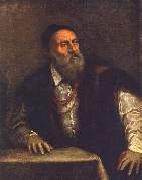 |
TIZIANO Vecellio
|
|
Italian painter, Venetian school (b. 1490, Pieve di Cadore, d.
1576, Venezia). |
|
 |
Tobias Stimmer
|
|
(7 April 1539 - 4 January 1584) was a Swiss painter and illustrator. His most famous work is the paintings on the Strasbourg astronomical clock. He died in Strasbourg.
He was born in Schaffhausen, and was active in Schaffhausen, Strasbourg and Baden-Baden as a wall and portrait painter. He made a great number of drawings for woodcuts (Bible scenes, allegories, etc.) which were published by the printer Sigmund Feyerabend in Frankfurt am Main, and Bernhart Jobin in Strasbourg.
Stimmer followed Hans Holbein the Younger, but developed his own mannerism. Among his wall paintings remain the "House zum Ritter" in Schaffhausen, although this was actually much restored and changed.
|
|
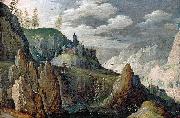 |
Tobias Verhaecht
|
|
(Antwerp, 1561 - 1631) was a painter and draughtsman active in Antwerp, Florence and Rome. Primarily a landscape painter, his style is indebted to mannerist world landscapes of artists like Joachim Patinir with high viewpoints, fantastic distant perspectives and three-colour scheme. Before Verhaecht entered Antwerp's guild of St. Luke in 1590-91, he had already spent time in Italy, first in Florence, and then as a fresco painter in Rome. Peter Paul Rubens, who was a relative by marriage, studied with him around 1592, and another student was his own son, Willem van Haecht. Verhaecht is also known for his designs for prints.
|
|
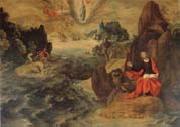 |
Tobias Verhaeght
|
|
1561-1631
was a painter and draughtsman active in Antwerp, Florence and Rome. Primarily a landscape painter, his style is indebted to mannerist world landscapes of artists like Joachim Patinir with high viewpoints, fantastic distant perspectives and three-colour scheme. Before Verhaecht entered Antwerp's guild of St. Luke in 1590?C91, he had already spent time in Italy, first in Florence, and then as a fresco painter in Rome. Peter Paul Rubens, who was a relative by marriage, studied with him around 1592, and another student was his own son, Willem van Haecht. |
|
|
|
|

